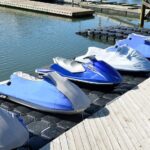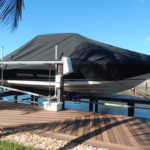The winter months are not too kind to boats. If you don’t know how to winterize a boat correctly, significant damage could occur, such as corroded water lines or a cracked engine block. These are expensive issues that you don’t want to experience.
It’s important to know how to winterize your boat so that it will be ready when the boating season comes.
How to winterize a boat? Winterizing a boat is a simple five-step process:
- Clean every inch of the boat
- Winterize the Engine and Lower Unit
- Winterize Fresh and Wastewater Systems
- Prepare the Interior and Cabin for Winter
- Inspect the Exterior and Trailer If They Are Fully Covered
I’ll cover in detail the parts of the boat that you should clean when winterizing your boat, including:
- Hull
- Bilge, Livewells, and Raw Water Washdowns
- Interior
- Plumbing System
- Fuel System
I’ll also cover in detail how to winterize a motor, including:
- Fill the Engine Tank with Gas and Add Fuel Stabilizer
- Add Antifreeze
- Spray Fogging Oils
- Change Engine Oil and Oil Filter
- Perform a Final Inspection
Read on to learn the proper way of winterizing your boat so that it is safe all winter and ready for next season.
How to Winterize a Boat
The project of winterizing your boat is more than just draining the engine oil, adding antifreeze, or adding fuel stabilizer to the remaining fuel. It is a comprehensive task that involves everything from the bow to the transom. Engines and boats also differ, so you need to check the operator’s manual for specific instructions on winterizing your boat.
But whether your boat is made of fiberglass, steel, aluminum, wood, or a combination of several materials, and whether it has an inboard or outboard motor, there are general tasks that you need to perform to prepare it for the winter. Some experienced boaters have organized the winterization of a boat to just five steps, namely:
- Cleaning – Clean every nook and corner of the boat before it goes into storage.
- Winterize the Engine and Lower Unit – Check and prepare for storage every part of the engine, whether it is an inboard or outboard engine.
- Winterize Fresh and Wastewater Systems – Check each water line and fixture.
- Prepare the Interior and Cabin for Winter.
- Inspect the Exterior and Trailer If They Are Fully Covered.
If you winterize the boat yourself, you can be sure that everything will be done right. You can also save hundreds of dollars since you won’t be paying a local dealer or local yard to do the work.
Parts of the Boat That You Should Clean
Every part of your boat has a role to play in making your sailing trips safe and enjoyable. Each of these parts should be checked and cleaned. If you are unsure, check your owner’s manual for instructions. What are the boat parts that you should check and clean?

1. Hull
A significant part of the boat that you should check is the hull. Inspect the bow eye, which is where you commonly see stress cracks and gel coat blisters. If you see cracks in this section, it could indicate structural damage in the boat. And if the crack is big, ask a professional to inspect it.
Scrape off barnacles and other free riders on the bottom of your boat. If there are any residues left behind, sand them. Use a pressure washer to remove other dirt and sea scums. Once you are through cleaning the hull, use marine paste wax. This wax will create a protective acrylic shield on the hull surface and prevent dirt from penetrating through the wax.
2. Bilge, Livewells, and Raw Water Washdowns
Any part of the boat that holds water should be drained, including the bilge pumps. Run livewell pumps and raw water washdowns until all their water residues are dry. Don’t stop until there are no more gurgling sounds coming out from them. If there is water in places that can’t be drained, give them enough doses of antifreeze.
3. Interior
Vinyl interiors are not very resistant to winter conditions. To protect them, get some vinyl cleaners and protectants. They will prevent vinyl materials from cracking and drying out. These products are available in sprays and gel form.
You should also protect your boat interiors from moisture. Don’t allow moisture to enter your boat before it hibernates. Moisture will develop into mildew and can encroach in any part of your interiors. Spraying chemical dehumidifiers will help. To reduce the chances of trapped moisture, vent the cover of your boat to allow good airflow.
Moisture can also penetrate the appliances inside the boat and damage the electronics and electrical system. It pays to have a wired electrical system according to marine standards. If you don’t have this kind of wiring system, you can spray exposed electrical connections with a lubricant that fights off moisture. Remove electronic items and store them in a place away from the ravages of winter.
Conduct a thorough cleaning of all the interior areas of the boat. These areas should include the deck, transom, stern, galley, berth, cabins, head, helm or cockpit, and so on. Also, your work should include vacuuming and washing of carpets and floors. All the work should have one goal: to clean and brighten up everything inside the boat.
4. Plumbing System
Water is one element that poses the greatest danger in your boat. During winter, all kinds of liquid freezes and can cause cracks in engines and busted water pipes, including molds and mildews in the interior.
All heads, tanks, and sinks should be fully drained. You should also run through non-toxic antifreeze in them. Open all valves and faucets until the freshwater tank is completely empty. Close all faucets and valves and add antifreeze to the tank.
Then open the farthest faucet or valve from the tank. Wait for the antifreeze to flow out. Next, close that outlet. Repeat this process on all water systems in your boat. You may also do this process on the boat heads and all systems that hold water or liquid inside your boat. If you have a removable head on your boat, you should clean and dry it before storing it.
5. Fuel System
If a gasoline engine powers your boat, you need to winterize its fuel system. The most important thing is to add a dose of quality fuel-stabilizing additive to the fuel tank.
After a dose of additive, run the engines to allow treated fuel to circulate in the entire fuel system. You should also replace the fuel filters of the engine as well as the fuel/water separators. Don’t make the mistake of reusing an old filter, as it can damage the internal components of your engine.
So now we know how to clean a boat in preparation for the winter. Next, let’s look at how to winterize a boat motor, including how to winterize an inboard outboard boat, as well as each boat type.
How to Winterize an Inboard Boat Motor
You need to perform these five steps on how to winterize an inboard boat motor:
1. Fill the Engine Tank with Gas and Add Fuel Stabilizer
You don’t want air to get inside the fuel tank. This occurrence will happen if you leave the fuel tank empty. Air always contains some amount of moisture. This moisture will eventually condense into water.
This water condensate will mix with gas the next time you fill up the tank. Gas with water is bad for the engine. It causes corrosion inside the engine’s cylinder. This type of engine damage is expensive to repair.
Adding a fuel stabilizer will also prevent the buildup of moisture in the fuel. You should do this whenever you are storing gas for an extended time. It works to stop the oxidation and chemical breakdown of the fuel. Next, run the engine while it is still on the water.
2. Add Antifreeze
An antifreeze will prevent liquid or moisture inside the engine from freezing. Without it, the fuel inside the engine will freeze. As it freezes, the volume expands. This expansion will cause cracks in the cylinders or the engine block itself.
3. Spray Fogging Oils
The next step is to spray fog oils into the combustion chambers. They will leave a protective coat of oil or lubricant on the walls of the cylinders. Moreover, they prevent corrosion and also function as a lubricant the next time you start the engine.
Simply take out the individual spark plugs from their sockets and then spray fogging oil directly into the combustion chamber.

4. Change Engine Oil and Oil Filter
Draining and changing the engine oil now while your motor is still warm is easier than doing it next spring. Additionally, leaving old engine oil inside the engine will allow contaminants, such as dirt and other particles, to do their dirty work. So, it is wiser to winterize the engine with new engine oil. With the oil changed, you also need a new oil filter.
5. Perform a Final Inspection
Perform the following final inspection before storing the engine:
- Seal off Cracks from the Intake. The cracks will allow moisture to go into the inner chambers of the engine and cause problems.
- Check If There’s Corrosion in the Exhaust System. Look for signs of corrosion and rust buildup. Check that no obstructions are present in the raw water injection hose.
- Inspect All Hoses and Their Clamps. After long use, hoses get damaged. Check for cracks, rust, or shredded parts. Replace hoses and clamps that are old and damaged.
How to Winterize an Outboard Boat Motor
An outboard motor is generally the same as an inboard motor. The main difference is that the former is installed at the back of the boat, while the latter is inside the boat. As such, winterizing an outboard boat motor should be basically the same as that of the inboard motor.
But aside from following the winterizing procedures of inboard motors, there are still some things you need to do in an outboard motor. Before doing any maintenance work on your outboard motor, consult the owner’s manual. Here are some of those things:
- You need to tilt the engine all the way down to completely drain all the water from its cooling system.
- Flush your outboard’s engine with fresh water
- After flushing, dry the engine completely. No moisture should be left on the insides of the engine.
- Drain the fuel from the engine. A bit of fuel is often left on the engine. Then, turn on the engine. Just before the fuel runs out, take the fogging oil sprayer and spray on the carburetor. This will provide a coat of protection in the cylinders and other internal engine parts from corrosion.
- Change the outboard’s engine oil and gear oil, as well as the oil filter.
- Follow other applicable processes of winterizing inboard motors.
Cover the Boat Completely for the Winter
Check the bilge of the boat. You should remove the drain plugs. Check the parts below the deck, as well. Be sure that the boat is in the proper position to drain water thoroughly. If everything checks out right, it is now time to cover the boat.
Make sure that boat is covered down to its waterline. If you are using polytarp covers or polyvinyl covers, you should strengthen them with a frame. It will distribute the weight of snow evenly. Build a frame that will fit the size of your boat with some allowance. You can use PVC pipes of 2 x 2s or 2 x 4s. Also, you can use shrink wrap to cover your boat. Just be sure that they’re strong enough to hold the weight of snow.
Other Boat Winterizing Tips
Besides knowing how to winterize a boat motor, there are some other little things that you must not forget. They are as follows:
- Don’t forget the battery. Remove it and store it indoors.
- Make provisions for pest control. Install pest repellants to discourage pests from hibernating in your boat.
- Check your boat regularly. It will discourage burglars from stealing things from your boat.
Conclusion – How to Winterize a Boat
So, to recap, how do you winterize a boat? Winterizing a boat is a simple five-step process:
- Cleaning – You should clean every nook and corner of your boat before it goes into hibernation.
- Winterize the engine and lower unit – Whether it is an inboard or outboard engine, every part of it should be checked and prepared for storage.
- Winterize the fresh and wastewater systems – Every pipe and fixture must be checked.
- Prepare the interior and cabin for winter.
- Inspect the exterior and trailer if they are fully covered.
Knowing how to winterize a boat is one thing, but actually doing it takes a concerted effort.
Related reading:
Best Boat Cover Material Plus Our Top 5 Covers


![Spot-Lock Trolling Motor [What Is It? and Best Spot-Lock Motors] spot lock trolling motor](https://boatinggeeks.com/wp-content/uploads/2021/06/spot-lock-trolling-motor-150x150.jpg)




![Read more about the article Sea-Doo Boat [Jet Boat Specs and Review]](https://boatinggeeks.com/wp-content/uploads/2021/03/Sea-Doo-boat-300x200.jpg)

![Read more about the article Tri-Hull Boat [What Is It and Its Pros and Cons]](https://boatinggeeks.com/wp-content/uploads/2021/04/tri-hull-boat-300x200.jpg)